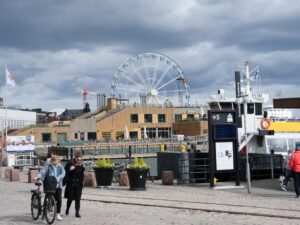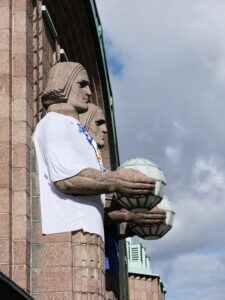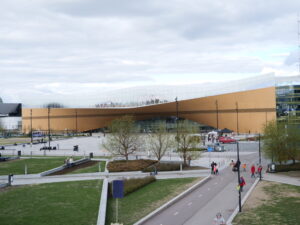Fulbright Finland Awards Ceremony and Reception – Helsinki
I spent tonight (May 17th) at the Helsinki City Hall enjoying a ceremony and reception held by Fulbright Finland honoring in part the 70th anniversary of the Fulbright Finland program. The award ceremony acknowledges the thirty or more Finnish Fulbright awardees that will spend part of the upcoming year in the United States. Speakers included the Mayor of Helsinki, the Finnish State Secretary to the Minister for Foreign Affairs, and the CEO of the Fulbright Finland Foundation. They were joined by the newly appointed U.S. Ambassador to Finland. Each of the individuals with ties to the US or Finnish government commented on today’s Finnish Parliament’s overwhelming vote (188 to 8) in favor of Finland joining NATO. This would have been unheard of just a few years ago. But all acknowledged that the security situation for Finland has changed dramatically since the Russians invaded Ukraine in late February. Russia and Finland share an at times violent history and an 830 mile (1340 km) long border. A musician and U.S. Fulbright Fellow, Alyssa Rodriguez, played an original composition entitled Uncertain Times on a Swedish keyed fiddle (nyckelharpa) to end the formal ceremony. The title of her piece seems all too fitting.

I arrived on Sunday afternoon and walked around Helsinki until early evening. Helsinki is a vibrant cosmopolitan capital that sits on the shores of the Gulf of Finland which is part of the Baltic Sea. Highlights of my walking tour of Helsinki included seeing the snow white Helsinki Cathedral. This Cathedral dates to 1852 and it was originally built to honor Tzar Nicholas I of Russia. At the time of the cathedral’s construction Finland was part of Russia and Finland was known as the Great Duchy of Finland. The building architect borrowed elements from several cathedrals in St. Petersburg, Russia. The Helsinki Cathedral is one of the most recognizable buildings in all of Finland.



A second cathedral, the Eastern Orthodox Uspenski Cathedral, is close by. This cathedral was built in 1862–1868 and is made of approximately 700,000 bricks. The construction of the two cathedrals have a link to Alexander I who in 1812 declared that a percentage of the salt import tax were to be used to fund construction of both a Lutheran and Orthodox church (Salt Tax Cathedrals). Despite this plan, construction of the Orthodox Cathedral was largely supported by parishioners and private donors.



The harbor area is a short walk from the two cathedrals.


The Central Railway Station (Helsingin päärautatieasema) is a 15 minute walk from the harbor. The station was built in 1919 and is adorned with four granite statutes (stone men holding lanterns). They are usually “undressed” although during covid they wore surgical masks. They are wearing the Suomi (Finland) shirts because Helsinki is hosting the International Ice Hockey Federation championship. Finland defeated the US yesterday (4-1).


I wrapped up my day by visiting the Oodi, Helsinki’s central library (Helsingin keskustakirjasto Oodi). The building was dedicated in 2018. I arrived there about 7:00 pm and it was packed with patrons (it’s no wonder that the Finn’s education system is ranked among the best in the world). They loan or have available most everything you can think of including books, music, movies, computer and board games, as well as puzzles. You can also use sewing machines and electric guitars. They have an electronics workstation with three D printers, laser cutters, and other equipment. The library has specialty rooms (e.g., music studios) as well as numerous small and large rooms including several equipped with smart glass.



 .
.
In my next blog I’ll discuss my trip to Porkkalanniemi and Porkalla National Park.
- Categories: